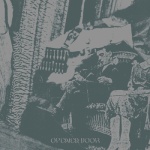. issue XVIII : ii .
. artist : aaron dilloway .
. album : opened door .
. year : 2013 .
. label : chondritic sound .
. grade : b plus .
Just in time for Halloween, here’s a charismatic and eerie cassette from sound artist Aaron Dilloway. Opened Door presents sounds that emerge as a result of the natural currents of place — creaking swings, slapping shutters — but that we aren’t always able to write off as contingent on physical forces; instead, the vigilant human mind can’t help but hear rhythm, therefore, method, and thus, attribute sentience.
It’s a very Chondritic release, whose cover (in the label’s grim documentary style) doesn’t just happen to evoke the subdued, character-driven pensive-in-tweed sophistication of Victorian horror. Dilloway himself, in dark suit and Beardsley pose, sits next to a frocked but headless manikin.
But what begins as kitsch — the cover, the titular ‘opening’ screak — becomes obviously sincere after a minute or so. It turns out that Opened Door isn’t ‘spooky’ — it’s a serious project of merit. On the A side, doors or swings groan and meow over the low-level grumbles and appropriated murmurs of conversation. Stuttering swathes of noise rumble their strata; cackling laughter is diffused by static; Midwestern downpours submerge the axle rod prattle of the wagon’s weathering; a Theremin ghost warbles soprano. Then, harrowing windstorms; ball-and-chain hobbles; stomping suits of armor; keening cats or babies; and wind whistles: locomotor at full speed.
Side B explores air as a tool for appraising the topography of spatial environs. We enjoy ghastly hollows, dispersed foliage, and tight crevices in this minimal but goosebump-inducing piece. Are the resonances manifesting ‘from thin air’ (not so — there’s a source of production in a space) inorganic or organic, ephemeral or concrete? How to tell? (You can’t.) Motion of wind is also explored, a crushing dynamo winds (har) up this ethereal music box in a early winter squall. Also present germane are comparisons between organic and inorganic ‘physiognomy,’ as when a rockwall whistle and the howls of wolves bring to mind how the crevice mirrors the throat, and with the recognizably human aspects inherent in the wind: faltering cracks and regular exercise (hold, let go go go go) invoking the inflation, suspension and relaxation of the diaphragm. A burgeoning metallic tape sound approaches the close, and coming to possess and encapsulate, is a solid, game-changing final moment of suspense — before stopping short.

